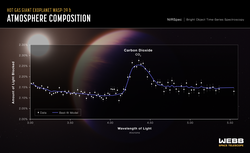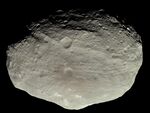Astronomy:WASP-39b
 Exoplanet WASP-39b artist's concept[1] | |
| Discovery | |
|---|---|
| Discovery site | WASP[2] |
| Discovery date | 2011[2] |
| Primary transit[2] | |
| Orbital characteristics | |
| 0.0486±0.0005 AU, (7.27±0.1)×106 km | |
| Eccentricity | 0[2] |
| Orbital period | 4.05526[2] d |
| Inclination | 87.83±0.25[2] |
| Star | WASP-39[2] |
| Physical characteristics | |
| Mean radius | 1.27±0.04[2] |♃|J}}}}}} (91000±3000 km) |
| Mass | 0.28±0.03[2] |♃|J}}}}}} |
| Mean density | 180±40 kg m−3 |
WASP-39b, officially named Bocaprins, is a "hot Jupiter" extrasolar planet discovered in February 2011[3] by the WASP project, notable for containing a substantial amount of water in its atmosphere.[1][4][5] In addition WASP-39b was the first exoplanet found to contain carbon dioxide in its atmosphere,[6][7] and likewise for sulfur dioxide.
WASP-39b is in the constellation Virgo, and is about 700 light-years from Earth.[1] As part of the NameExoWorlds campaigns at the 100th anniversary of the IAU, the planet was named Bocaprins, after the beach Boca Prins (de) in the Arikok National Park of Aruba.
Characteristics

WASP-39b has a mass of about 0.28 times that of Jupiter and a radius about 1.27 times that of Jupiter (91,000 km).[2] It is a hot gas giant planet with a high temperature of 900 °C.[6] The exoplanet orbits very close (7 million km) to WASP-39, its host star, every 4 days.[1]
WASP-39b is also notable for having an extremely low density, near that of WASP-17b. While WASP-17b has a density of 0.13±0.06 g/cm3, WASP-39b has a slightly higher density of 0.18±0.04 g/cm3.
Atmospheric composition

Hot water molecules were found in the atmosphere of WASP-39b in a 2018 study.[1] The atmospheric transmission spectra, taken by different instruments, were inconsistent as in 2021, possibly indicating a disequilibrium atmospheric chemistry.[8] High-fidelity spectra obtained by the James Webb Space Telescope in 2022 did not confirm a disequilibrium chemistry.
WASP-39b is one of the James Webb Space Telescope's early release science targets. Sulfur dioxide was observed in this planet's atmosphere for the first time, or indeed of any planet outside of the Solar System, indicating the existence of photochemical processes in the atmosphere.[9] WASP-39b is the first exoplanet in which carbon dioxide has been detected.[6][10][7]
Planetary transmission spectra taken in 2022 has indicated the atmosphere of WASP-39b is partially cloudy, and planet C/O ratio appears to be subsolar.[11] The spectral signature of water, carbon dioxide, sodium[12] and sulfur dioxide were also detected.[13]
WASP-39 (star)
| Observation data Epoch J2000.0 Equinox (celestial coordinates) | |
|---|---|
| Constellation | Virgo |
| Right ascension | 14h 29m 18.4151689656s |
| Declination | −03° 26′ 40.204480380″ |
| Apparent magnitude (V) | 12.09 |
| Distance | 702 ± 2 ly (215.4 ± 0.7 pc) |
| Other designations | |
2MASS J14291840-0326403, Gaia DR2 3643098875168270592, Gaia EDR3 3643098875168270592 | |
| Database references | |
| SIMBAD | data |
The parent star WASP-39 is of spectral class G and is slightly smaller than the Sun. It lies in the Virgo constellation, 698 light-years from Earth.[1] The star WASP-39 was formally named Malmok in 2019.[14][15]
See also
- WASP-6b
- WASP-17b
- WASP-19b
- WASP-31b
- WASP-121b
- List of proper names of exoplanets (see section Sources in References)
- List of transiting exoplanets
- List of exoplanets discovered in 2011
References
- ↑ 1.0 1.1 1.2 1.3 1.4 1.5 Cofield, Calla; Jenkins, Ann; Villard, Ray (1 March 2018). "NASA Finds a Large Amount of Water in an Exoplanet's Atmosphere". NASA. https://www.jpl.nasa.gov/news/news.php?feature=7072.
- ↑ 2.00 2.01 2.02 2.03 2.04 2.05 2.06 2.07 2.08 2.09 "Planet WASP-39 b". Extrasolar Planets Encyclopaedia. 2018. https://exoplanet.eu/catalog/wasp_39_b--818/. Retrieved 1 March 2018.
- ↑ Faedi, Francesca et al. (7 February 2011), "WASP-39b: A highly inflated Saturn-mass planet orbiting a late G-type star", Astronomy & Astrophysics 531: A40, doi:10.1051/0004-6361/201116671, Bibcode: 2011A&A...531A..40F
- ↑ Wakeford, H.R.; Sing, D.K.; Deming, D.; et al. (21 December 2017). "The Complete Transmission Spectrum of WASP-39b with a Precise Water Constraint". The Astronomical Journal 155 (1): 29. doi:10.3847/1538-3881/aa9e4e.
- ↑ "NASA finds a large amount of water in an exoplanet's atmosphere". Phys.org. 1 March 2018. https://phys.org/news/2018-03-nasa-large-amount-exoplanet-atmosphere.html.
- ↑ 6.0 6.1 6.2 6.3 Adkins, Jamie (2022-08-25). "NASA's Webb Detects Carbon Dioxide in Exoplanet Atmosphere". http://www.nasa.gov/feature/goddard/2022/nasa-s-webb-detects-carbon-dioxide-in-exoplanet-atmosphere.
- ↑ 7.0 7.1 Overbye, Dennis (26 August 2022). "Webb Telescope Sees a Carbon Dioxide Atmosphere Way Out There - WASP-39b, a distant world with a mass equivalent to Saturn's, is the first exoplanet known to harbor the gas.". The New York Times. https://www.nytimes.com/2022/08/26/science/space/webb-telescope-wasp-exoplanet.html. Retrieved 27 August 2022.
- ↑ Kawashima, Yui; Min, Michiel (26 October 2021), "Implementation of disequilibrium chemistry to spectral retrieval code ARCiS and application to 16 exoplanet transmission spectra", Astronomy & Astrophysics 656: A90, doi:10.1051/0004-6361/202141548
- ↑ NASA's Goddard Space Flight Center (22 November 2022). "NASA's Webb Reveals an Exoplanet Atmosphere as Never Seen Before". https://www.nasa.gov/feature/goddard/2022/nasa-s-webb-reveals-an-exoplanet-atmosphere-as-never-seen-before.
- ↑ The JWST Transiting Exoplanet Community Early Release Science Team et al. (2023), "Identification of carbon dioxide in an exoplanet atmosphere", Nature 614 (7949): 649–652, doi:10.1038/s41586-022-05269-w, PMID 36055338, Bibcode: 2023Natur.614..649J
- ↑ Rustamkulov, Zafar (2023), "Early Release Science of the exoplanet WASP-39b with JWST NIRSpec PRISM", Nature 614 (7949): 659–663, doi:10.1038/s41586-022-05677-y, PMID 36623548, Bibcode: 2023Natur.614..659R
- ↑ Ahrer, Eva-Maria (2023), "Early Release Science of the exoplanet WASP-39b with JWST NIRCam", Nature 614 (7949): 653–658, doi:10.1038/s41586-022-05590-4, PMID 36623551, Bibcode: 2023Natur.614..653A
- ↑ Alderson, Lili; et al. (2023), "Early Release Science of the exoplanet WASP-39b with JWST NIRSpec G395H", Nature 614 (7949): 664–669, doi:10.1038/s41586-022-05591-3, PMID 36623549, Bibcode: 2023Natur.614..664A
- ↑ "Approved names" (in en). http://www.nameexoworlds.iau.org/final-results.
- ↑ "International Astronomical Union | IAU". https://www.iau.org/news/pressreleases/detail/iau1912/.
External links
Coordinates: ![]() 14h 29m 18.0s, −03° 26′ 40″
14h 29m 18.0s, −03° 26′ 40″
 |




